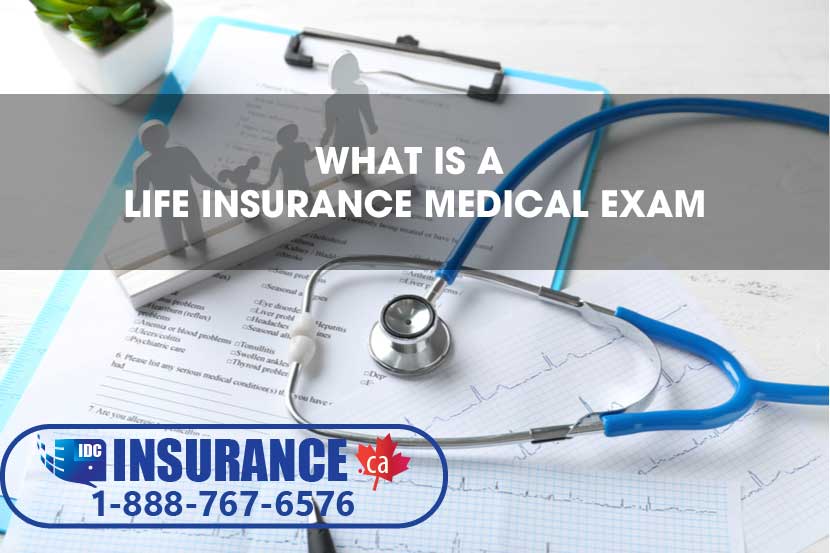Getting life insurance can take time and effort. One step that generates a lot of questions is the life insurance medical exam. This guide will give Canadian readers everything about life insurance medical exams.
What is a Life Insurance Medical Exam?
A life insurance medical exam is a routine part of applying for most life insurance policies in Canada. It is a way for insurance companies to evaluate your health status and risk factors.
The exam typically takes 30-45 minutes and is conducted by a paramedical examiner, usually a nurse. The insurance company covers the cost of this exam.
The exam consists of two main components:
Health and Lifestyle Questionnaire
The examiner will ask you a series of questions about your medical history, family health history, prescription medications, alcohol use, smoking, and other lifestyle factors. Answer all questions thoroughly and honestly.
Physical Measures and Fluid Samples
The examiner will take your height, weight, blood pressure, pulse, and respiratory rate. They will also collect small blood and urine samples to send to a lab for testing.
Why Do Insurance Companies Require a Medical Exam?
Insurance companies want to properly assess the risk of insuring you. Your medical exam results give underwriters a clear picture of your current health status. This allows them to classify you into an appropriate risk category and determine fair premium pricing.
Applicants who are healthy and have minimal risk factors will qualify for lower premiums. Those with significant health issues may be rated (charged higher premiums) or even denied coverage.
What is Tested in a Life Insurance Medical Exam?

The two components of the life insurance medical exam allow insurance companies to get a comprehensive overview of your health. Here are specifics on what is tested:
Blood Testing
Blood tests check for any medical conditions that may impact mortality risk. Some critical things screened for include:
- Cholesterol levels – elevated levels increase the risk of heart disease
- Liver enzymes – may indicate liver dysfunction
- Kidney function
- Diabetes – blood glucose and HbA1c levels
- Immune disorders – HIV, hepatitis
- Prostate cancer – PSA test for males over 50
- Nicotine/tobacco use
- Prescription and illicit drug use
Urine Testing
Urine is tested to evaluate health status further. Some critical things screened for include:
- Protein levels – can indicate kidney disorders
- Glucose levels – screens for diabetes
- Blood or red blood cells – may indicate infections, kidney issues, or cancers
- Nicotine/tobacco use
- Prescription drug and illicit drug use
Other Testing
Additional tests may be required depending on your age and the amount of coverage applied for. These can include:
- Electrocardiogram (EKG) – evaluates heart health
- Chest X-ray
- Blood pressure during activity
- Cognitive testing
Why are Fluid Samples Tested?
Blood and urine samples provide objective data that clearly shows your health status. People self-reporting things on the initial application may only tell part of the story or be intentionally false. Fluid samples help ensure life insurance companies have accurate health data before issuing a policy.
Some key reasons samples are tested:
- Verify non-smoking status
- Uncover undisclosed drug use
- Detect medical conditions applicants are unaware of
- Confirm medications match conditions reported
- Validate reported alcohol consumption
- Evaluate kidney and liver function
- Check for prostate cancer, HIV, hepatitis, and other serious illnesses
What Happens if Something Abnormal is Detected?
If potential issues are revealed during your exam, the insurance company will likely request additional information from you and your doctor before making a final underwriting decision.
Things that may warrant follow-up:
- Elevated liver enzymes
- High cholesterol
- Presence of blood in urine
- High blood pressure
- High PSA levels
- Nicotine detected in non-smokers
- Prescription drugs that don’t match disclosed conditions
Rather than automatically declining your application, the insurer will work to understand the reasoning behind unusual results. Specific conditions may require a temporary postponement until things improve or stabilize.
Providing honest context will give you the best chance for acceptance. Trying to hide medical issues often leads to denial of coverage in the future.
How to Get the Best Results on Your Life Insurance Medical Exam
While you can’t change underlying health conditions, you can take steps to prepare your body and get the most accurate test results possible:
- Fast for 8-12 hours beforehand. This ensures blood sugar and cholesterol levels reflect typical readings.
- Avoid strenuous exercise the day before the exam. Activity can temporarily skew some results.
- Limit salt, sugar, and fatty foods the day before. This helps keep blood pressure stable.
- Stay well hydrated leading up to the exam. Being dehydrated makes drawing blood more difficult.
- Avoid tobacco, nicotine, alcohol, and recreational drugs for at least 48 hours beforehand.
- Take all prescription medications as usual. Make sure the examiner records them accurately.
- Reschedule your exam if you are sick. Illness can impact the accuracy of results.
- Relax and stay calm during the exam itself. This will provide the most normal vital sign readings.
Understanding Life Insurance Lab Results
Once your paramedical exam is complete, it takes approximately 2 weeks for the lab results to be available to the insurer. If you are curious about your results, you can request a copy from your insurance company.
Some things that may be concerning at first are often normal variations. Going over your detailed lab report with your family doctor is recommended.
Here are explanations of some common test results:
| Elevated liver enzymes (ALT, AST) | This could indicate liver dysfunction but are often caused by medication use, supplements, or intense exercise, generally only concerning if very high. |
| High cholesterol (over 200) | Dietary changes may be needed. Your doctor can advise treatment if over 240. Values under 200 are ideal. |
| Low HDL (under 40) | The “good” cholesterol – Levels below 40 increase the risk of heart disease. HDL over 60 is protective. |
| High LDL (over 100) | The “good” cholesterol – Levels below 40 increase the risk of heart disease. HDL over 60 is protective. |
| High triglycerides (over 150) | Can be caused by overweight, inactivity, diet, or genetics. Values over 500 increase pancreatitis risk. Under 100 is best. |
| Elevated A1C (over 5.7%) | Can indicate prediabetes if between 5.7 – 6.4%. Over 6.5% indicates diabetes. Below 5.7% is normal. |
| High serum glucose (over 100 fasting) | Fasting glucose between 100-125 is prediabetes. Over 126 is diabetes. Under 100 is normal. |
| High creatinine (over 1.3) | Can indicate impaired kidney function. Creatinine levels tend to increase with age naturally. |
| Low eGFR (under 60) | Reduced kidney filtering ability. Generally, it is only a concern under 30. Over 90 is optimal. |
| Blood in urine | Called hematuria, it has many causes, including infections, kidney stones, and rarely cancers. Follow-up needed. |
What if Something Abnormal is Found in My Results?
Try not to panic if you get unexpected lab results back. Remember, life insurance companies will request follow-up details from you and your doctor before deciding.
Here are 7 tips on handling abnormal lab test results:
- Don’t hesitate to ask your life insurance broker and doctor to explain the findings. Get clarity on what they mean.
- Disclose any additional context openly – this gives underwriters the complete picture. Hiding information never pays off.
- Be responsive to insurer requests for records or added testing. Delays can negatively impact your application.
- If a medical issue is detected, take active steps to improve it before reapplying. Insurers like to see positive health progress.
- Get rated rather than declined – this gets you coverage, albeit at a higher premium. Some protection is better than none.
- If ultimately declined, ask your broker to shop your case to other insurers. You may find someone willing to take on your specific risk factors.
- Consider a “guaranteed issue” simplified policy with limited coverage just to get initial benefits in place. You can potentially convert to better coverage later on.
With the proper guidance and persistence, most Canadians can qualify for some life insurance protection.
How to Disclose Medical Conditions

Failing to disclose known medical conditions is one of the main reasons life insurance applications get declined. It leads insurers to believe you intentionally withheld material facts about your health.
To avoid headaches, here are some tips on how to adequately disclose medical issues:
- Note your symptoms and planned diagnostic steps if an issue is severe but not officially diagnosed. Insurers want visibility.
- Disclose a family history of significant conditions like heart disease, cancer, or neurological diseases. Genetic predispositions matter to underwriters.
- Use the exact medical terminology if you know it rather than general descriptions. For example, disclose “Type 2 diabetes” rather than “high blood sugar issues.”
- Authorize access to all medical records early in the process. Attempts to hide files may seem like you are downplaying health concerns.
- If hospitalized for surgeries, illnesses, or accidents, note all discharge diagnoses – often secondary conditions are identified.
- List all prescription and over-the-counter medications, supplements, inhalers, and machines like CPAPs. Attempting to conceal prescribed treatment raises red flags.
Giving insurers a complete picture of your medical situation right away can streamline the underwriting process and prevent delays or surprise denials down the road.
Should I Disclose Marijuana or CBD Oil Use?
With the legalization of recreational cannabis in Canada, many people wonder if marijuana usage needs to be reported on a life insurance application. The short answer is yes. Currently, most insurers still treat marijuana similar to tobacco when evaluating risk.
Failing to disclose marijuana or CBD oil use often leads to denial of life insurance for two reasons:
- Drug testing detects THC metabolites and shows the insurer your cannabis use was not reported truthfully.
- Insurers view undisclosed marijuana usage as an attempt to conceal material health information from underwriters.
While penalties for cannabis use are decreasing in Canada, it is still important to be transparent with marijuana habits upfront. This gives underwriters the whole picture to rate risk accurately.
Some tips on disclosing recreational marijuana or medical CBD oil use:
- Quantify frequency – daily, weekly, monthly? Report only factual usage.
- Specify method – smoking, vaping, oils, edibles? The method impacts health risks.
- List medical conditions treated with cannabis and CBD oil per doctor’s recommendations.
- Note if you plan to reduce or stop usage once insured. Some insurers re-rate premiums after 1-2 years of no THC use.
While cannabis disclosure may lead to smoker rates, being open provides the best chance at approval. Non-disclosure will very likely result in denial of life insurance.
What if I’m Declined for Life Insurance?
Being declined for life insurance can be upsetting but is not always permanent. Here are some tips for applicants who get denied:
- Find out the exact reasons for the decline. Then, work to improve those factors to requalify in the future potentially.
- Ask your insurance broker to re-shop your case to other insurers. You may find one more amenable to your particular conditions.
- Consider a guaranteed issue life insurance policy with limited coverage to get some initial benefits in place. You can convert it to better insurance later on.
- If declined due to marijuana use, reapply in 1-2 years after stopping consumption to get improved ratings potentially.
- Lifestyle changes like quitting smoking, losing excess weight, or lowering cholesterol may allow you to be insured.
- Monitor health improvements closely and keep detailed records—insurers like seeing positive progress.
- If declined due to a high-risk occupation, see if your employer provides any group life insurance options.
While being declined is discouraging, it does not need to be permanent. With guidance from an experienced broker and dedication to improving health, many previously declined applicants can eventually qualify for affordable life insurance in Canada.
Who Performs Life Insurance Medical Exams?
Paramedical examinations are conducted by trained professionals who specifically perform insurance exams for a living. There are a few prominent companies that insurance carriers use:
- ExamOne – The largest paramedical company in Canada. ExamOne conducts most life insurance exams and has the largest network of examiners nationwide.
- Superior Mobile Medics (SMM) – A national paramedical organization focused on convenience by sending nurse practitioners to applicant’s homes or offices.
How Much Does a Life Insurance Medical Exam Cost?
The good news is that the insurer pays for life insurance medical exams and requires no out-of-pocket costs from applicants. The insurance company covers the cost of the paramedical examiner visiting your home or office as part of the application process.
While exact pricing varies, a typical life insurance medical exam costs the insurer approximately $250-350 on average. Costs are higher for exams conducted at medical facilities versus home exams.
The insurance company gladly pays for the medical exam because it provides valuable health data to underwrite policies properly. The result is a more accurate risk assessment and fairer premium rates for all policyholders.
Some insurers even tout the medical exam as an added value proposition for applicants since it provides a free general health review that might detect unknown issues early on.
Life insurance medical exams provide a snapshot of current health status and risk factors through lab testing, vitals, and health history review. While invasive sounding at first, the exam is quick, painless, and often covered as a free health screening. Preparing mindfully and disclosing health honestly leads to the best experience and insurance outcome.
For affordable life insurance quotes in Canada, contact the experienced brokers at IDC Insurance today.









